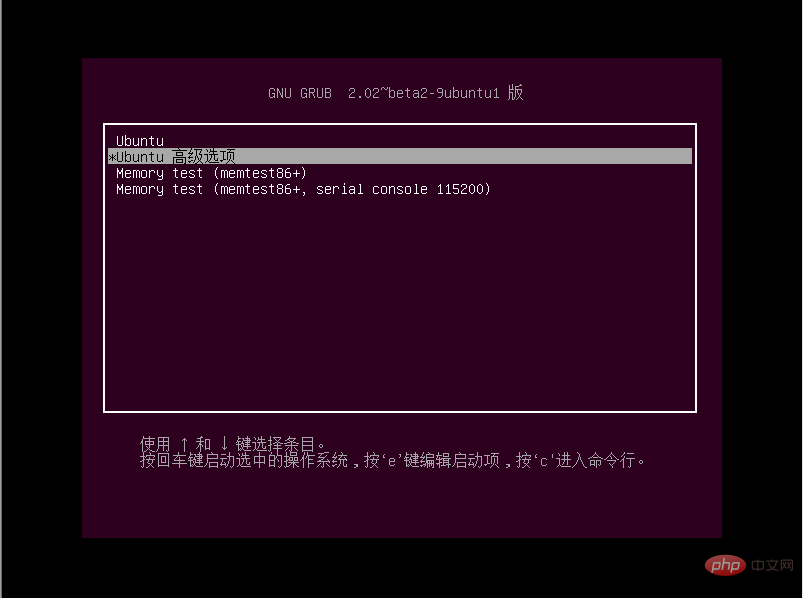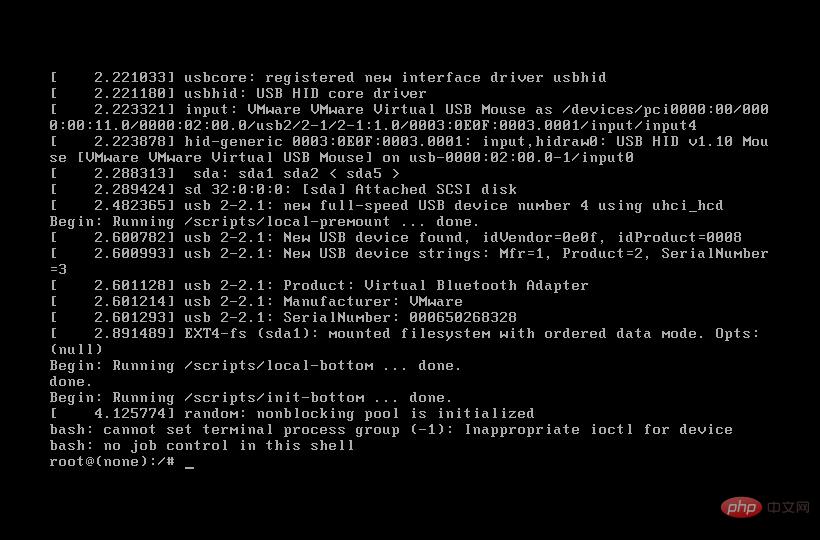what is linux single user mode
Linux single-user mode is a mode with superuser privileges when working on a Linux system. This mode can usually be entered by giving 1 or S parameter in the startup menu. This mode can only be entered through the boot menu when facing the host entity, thus ensuring that the super privilege is granted to the super user who has access to the host. This operation is usually used to maintain hard disk partitions or change the superuser password and other maintenance that need to be performed before the disk is mounted.

The operating environment of this tutorial: linux5.18.14 system, Dell G3 computer.
1. Linux user mode
0: Shutdown
1: Single user mode
2: Multi-user mode without network support
3: Multi-user mode with network support
4: Reserved, not used
5: Multi-user mode with network support and X-Window support
6 : Reboot the system, that is, restart
2. Single user mode
Single user mode (English: Single user mode) is a kind of super user when working on a Linux system. Permission mode. This mode can usually be entered by giving 1 or S parameter in the startup menu. This mode can only be entered through the boot menu when facing the host entity, thus ensuring that the super privilege is granted to the super user who has access to the host. This operation is usually used to maintain hard disk partitions or change the superuser password and other maintenance that need to be performed before the disk is mounted.
1. Single-user method
Since there are many ways to boot a Linux system, including common floppy disk boot, LILO boot, and GRUB boot, I have discussed several ways. Explain separately:
1.1 Floppy disk boot
When "BOOT:" appears after the floppy disk starts, you can set the startup parameters. Type "Linux single" here. "After that, you can start the system in single-user mode.
1.2 LILO mode
When starting in LILO mode, after the LILO prompt appears, you should quickly enter kernel/boot/vmlinuz-2.4.7-10 single roo= /dev/hda3, here I use REDHAT7.2, the kernel is 2.4.7-10, the general file name is vmlinuz when using it, you can copy this kernel file or establish a connection when the system is normal. single means single use. root=/dev/hda3 is the location of the root of the Linux system. My computer is equipped with 98, if it only has Linux. It may be /dev/hda1. On the second hard disk, it is /dev/hdb1. Here is how Linux identifies partitions.
1.3GRUB method
This method is more complicated to boot. When entering the GRUB startup screen, press "C" to enter the GRUB command line. When you have a password, press "P "After that enter the password and then proceed to the GRUB command line.
Enter the following command on the command line to enable single user. I still use REDHAT7.2 as an example to illustrate kernel /boot/vmlinuz-2.4.7-10 single root=/dev/hda3initrd/boot/initrd -2.4.7-10.img boot (hd0,2) The first and second sentences indicate the kernel file. The keyword for single user is still single. Depending on the system, the file name may be different. The meaning of boot (hd0,2) is to boot from the third partition of the
first hard disk.
2. Methods to prevent single-user entry
Since a single user has complete control over the system, if the operation is improper or is entered by others, the consequences will be disastrous. How to prevent single-user entry? , there are the following aspects to pay attention to.
2.1 Protect the /etc/inittab file. If you change 3 in id:3:initdefault to 1, you can directly enter single-user mode every time you start. For the /etc/inittab file, just enter chown700 /etc/inittab as root and set the properties so that other users cannot modify it.
2.2 If you are using lilo to boot, you may set the waiting input time during boot to 0 or the shortest time through Linuxconf or directly modify lilo.conf. In this case, if you enter single-user mode, you can use a floppy disk to boot.
2.3 If you use GRUB to boot, the simplest method is to use the GRUB password to protect the startup options.
2.4 In order to prevent others from remotely damaging and restarting the system, in addition to effectively managing the ROOT password and files in the /etc directory, the CMOS password should also be set, so that even if the system is changed to Even in single-user mode, you cannot directly start the computer to operate.
3. How to enter single-user mode in ubuntu
To enter single-user mode in ubuntu, you can use the command sudo init 1
Because there is a problem with the sudoer configuration file of the virtual machine, there is no way Using the sudo command, I couldn't remember the root password, so I studied how to enter single-user mode through recovery mode. Not much to say, the picture above: long press the shift key when starting the system to enter the grub menu:

Select ubuntu advanced options, press the e key

Select recovery mode, press e to enter the

modification The linux line
before modification:

after modification:

ctrl x Exit and enter single-user mode

Success
Note:
a. After modifying the grub configuration, the next time you enter recovery mode, the The content remains unmodified. If you want to enter single-user mode again, you need to modify it again.
b. If you want to restart after modification, reboot, shutdown -r, etc. are not feasible. You need to use ctrl alt delete through vmware.
The above is the detailed content of what is linux single user mode. For more information, please follow other related articles on the PHP Chinese website!

Hot AI Tools

Undresser.AI Undress
AI-powered app for creating realistic nude photos

AI Clothes Remover
Online AI tool for removing clothes from photos.

Undress AI Tool
Undress images for free

Clothoff.io
AI clothes remover

Video Face Swap
Swap faces in any video effortlessly with our completely free AI face swap tool!

Hot Article

Hot Tools

Notepad++7.3.1
Easy-to-use and free code editor

SublimeText3 Chinese version
Chinese version, very easy to use

Zend Studio 13.0.1
Powerful PHP integrated development environment

Dreamweaver CS6
Visual web development tools

SublimeText3 Mac version
God-level code editing software (SublimeText3)

Hot Topics
 What computer configuration is required for vscode
Apr 15, 2025 pm 09:48 PM
What computer configuration is required for vscode
Apr 15, 2025 pm 09:48 PM
VS Code system requirements: Operating system: Windows 10 and above, macOS 10.12 and above, Linux distribution processor: minimum 1.6 GHz, recommended 2.0 GHz and above memory: minimum 512 MB, recommended 4 GB and above storage space: minimum 250 MB, recommended 1 GB and above other requirements: stable network connection, Xorg/Wayland (Linux)
 Linux Architecture: Unveiling the 5 Basic Components
Apr 20, 2025 am 12:04 AM
Linux Architecture: Unveiling the 5 Basic Components
Apr 20, 2025 am 12:04 AM
The five basic components of the Linux system are: 1. Kernel, 2. System library, 3. System utilities, 4. Graphical user interface, 5. Applications. The kernel manages hardware resources, the system library provides precompiled functions, system utilities are used for system management, the GUI provides visual interaction, and applications use these components to implement functions.
 vscode terminal usage tutorial
Apr 15, 2025 pm 10:09 PM
vscode terminal usage tutorial
Apr 15, 2025 pm 10:09 PM
vscode built-in terminal is a development tool that allows running commands and scripts within the editor to simplify the development process. How to use vscode terminal: Open the terminal with the shortcut key (Ctrl/Cmd). Enter a command or run the script. Use hotkeys (such as Ctrl L to clear the terminal). Change the working directory (such as the cd command). Advanced features include debug mode, automatic code snippet completion, and interactive command history.
 How to check the warehouse address of git
Apr 17, 2025 pm 01:54 PM
How to check the warehouse address of git
Apr 17, 2025 pm 01:54 PM
To view the Git repository address, perform the following steps: 1. Open the command line and navigate to the repository directory; 2. Run the "git remote -v" command; 3. View the repository name in the output and its corresponding address.
 Where to write code in vscode
Apr 15, 2025 pm 09:54 PM
Where to write code in vscode
Apr 15, 2025 pm 09:54 PM
Writing code in Visual Studio Code (VSCode) is simple and easy to use. Just install VSCode, create a project, select a language, create a file, write code, save and run it. The advantages of VSCode include cross-platform, free and open source, powerful features, rich extensions, and lightweight and fast.
 How to run java code in notepad
Apr 16, 2025 pm 07:39 PM
How to run java code in notepad
Apr 16, 2025 pm 07:39 PM
Although Notepad cannot run Java code directly, it can be achieved by using other tools: using the command line compiler (javac) to generate a bytecode file (filename.class). Use the Java interpreter (java) to interpret bytecode, execute the code, and output the result.
 What is the main purpose of Linux?
Apr 16, 2025 am 12:19 AM
What is the main purpose of Linux?
Apr 16, 2025 am 12:19 AM
The main uses of Linux include: 1. Server operating system, 2. Embedded system, 3. Desktop operating system, 4. Development and testing environment. Linux excels in these areas, providing stability, security and efficient development tools.
 How to run sublime after writing the code
Apr 16, 2025 am 08:51 AM
How to run sublime after writing the code
Apr 16, 2025 am 08:51 AM
There are six ways to run code in Sublime: through hotkeys, menus, build systems, command lines, set default build systems, and custom build commands, and run individual files/projects by right-clicking on projects/files. The build system availability depends on the installation of Sublime Text.






